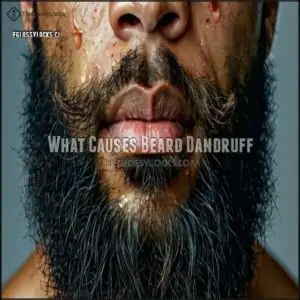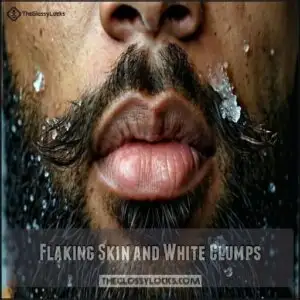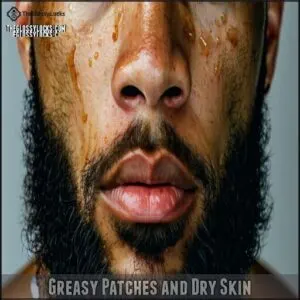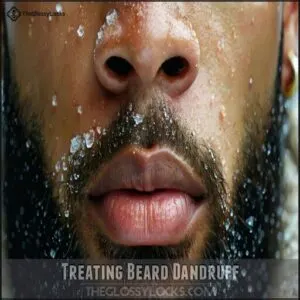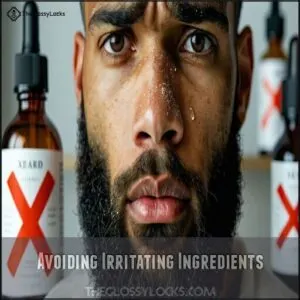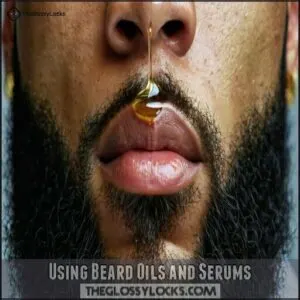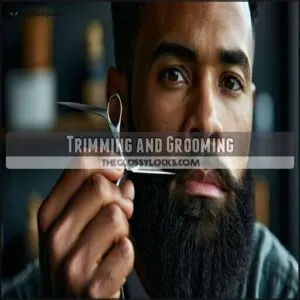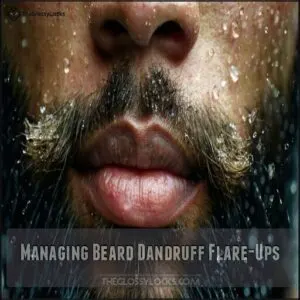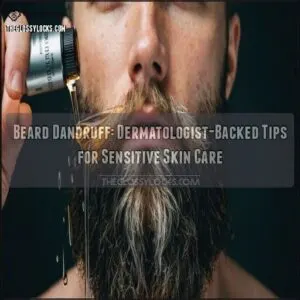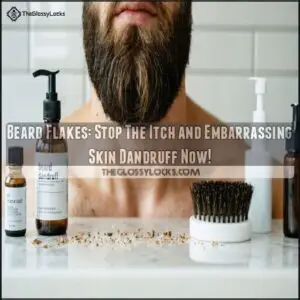This site is supported by our readers. We may earn a commission, at no cost to you, if you purchase through links.
 Beard dandruff treatment for Black men starts with understanding your hair’s unique needs.
Beard dandruff treatment for Black men starts with understanding your hair’s unique needs.
Coarse, curly hair often holds on to oils and dead skin, so regular care is key. Wash your beard 2-3 times a week with a gentle, sulfate-free beard shampoo to remove build-up.
Exfoliate your skin using a beard brush or a soft scrub to prevent flakes. Moisturize daily with a lightweight beard oil or balm—look for ingredients like jojoba or argan oil.
Anti-dandruff shampoos, like those with zinc pyrithione, can help too. If flakes persist, medicated creams might be your next step.
Healthy habits lead to a flake-free beard.
Table Of Contents
- Key Takeaways
- What Causes Beard Dandruff
- Symptoms of Beard Dandruff
- Preventing Beard Dandruff
- Treating Beard Dandruff
- Beard Care for Black Men
- Managing Beard Dandruff Flare-Ups
- Frequently Asked Questions (FAQs)
- How can you get rid of beard dandruff?
- How to reduce dandruff?
- How often should I treat beard dandruff?
- What is beard dandruff?
- Does trimming a beard help dandruff?
- When should I apply beard oil to prevent dandruff?
- How to get rid of beard dandruff black man?
- How can I stop dandruff in my beard?
- Is beard dandruff a fungus?
- How do I get rid of dead skin under my beard?
- Conclusion
Key Takeaways
- Wash your beard 2-3 times weekly with a sulfate-free or antifungal shampoo like Nizoral to remove flakes and fight fungus.
- Exfoliate gently with a beard brush or scrub to clear away dead skin and prevent clogged pores.
- Moisturize daily with lightweight beard oils like jojoba or argan to keep your skin hydrated and flakes at bay.
- Avoid irritating products with sulfates, alcohol, or petroleum, and use targeted treatments like ketoconazole cream for persistent dandruff.
What Causes Beard Dandruff
Your beard dandruff is primarily caused by a fungus called Malassezia that naturally lives on your skin and feeds on the oils in your beard.
Beard dandruff thrives on oil-loving Malassezia fungus, causing itchy flakes and irritation beneath your facial hair.
When this fungus overgrows, it creates an acid that irritates your skin and causes the flaking, itching, and redness you’re experiencing.
Malassezia Fungus
While you might think your beard flakes are just dry skin, they’re often caused by a fungus called Malassezia that naturally lives on everyone’s skin.
This microscopic organism feeds on the sebum (oil) in your beard area, creating byproducts that irritate your skin and trigger flaking.
For Black men, certain Malassezia strains can be particularly problematic, potentially leading to seborrheic dermatitis that requires targeted antifungal treatments.
Oily Skin Conditions
While Malassezia fungi initiate the problem, oily skin conditions create the perfect environment for beard dandruff to thrive.
Your sebaceous glands sometimes produce excess sebum, leading to three common issues:
- Pore clogging that traps dead skin cells
- Product buildup from heavy beard care products
- Disruption of your skin microbiome balance
This overproduction basically feeds the Malassezia, which converts sebum into irritating oleic acid, worsening seborrheic dermatitis symptoms.
Genetics and Family History
Your family tree plays a significant role in your beard health. Hair follicles and beard density are hereditary traits passed down generations, which can affect how your skin reacts to Malassezia.
Black men with family histories of seborrheic dermatitis face higher dandruff risks. Your growth patterns and baldness risk also influence oil production on facial skin, potentially creating ideal conditions for beard dandruff to develop.
Regular exfoliation can help prevent blocked hair follicles.
Environmental Factors
While your genes play a role, your environment substantially impacts your beard health too.
Seasonal changes often trigger dandruff flare-ups in black men’s beards.
Winter’s dry air strips moisture, while summer humidity can boost fungal growth.
Indoor heating, air conditioning, and poor air quality further stress your skin.
UV rays from sun exposure can damage follicles, creating an ideal environment for dandruff to thrive in black beard grooming routines, which can be influenced by seasonal changes.
Symptoms of Beard Dandruff
You’ll notice beard dandruff when your facial hair area becomes itchy with visible white flakes, redness, or greasy patches appearing throughout your beard.
Itchy skin and white flakes in your beard? Dandruff’s calling card, often paired with redness and those stubborn greasy patches.
The Malassezia fungus causes these symptoms by breaking down skin oils into irritating compounds, leading to faster skin cell turnover and that frustrating buildup under your beard, which results in itchy areas.
Itchiness and Redness
Scratching your itchy beard constantly? That persistent itch and redness under your beard are telltale symptoms of beard dandruff for Black men.
Inflammation often appears as red, irritated patches that can worsen with scratching.
- Sensitive skin beneath coarser beard hair experiences higher discomfort levels when Malassezia fungus irritates follicles
- Underlying conditions like seborrheic dermatitis intensify inflammation control challenges
- Beard care for Black men requires special attention to prevent skin irritation from becoming chronic
Flaking Skin and White Clumps
Spotting visible flakes and white clumps in your beard is the clearest sign of beard dandruff.
These flakes often collect at the base of hair follicles and can range in severity levels from barely noticeable to highly visible.
The clump composition typically consists of dead skin cells mixed with natural oils, creating distinct white buildup.
Black men’s beards may show these flakes more prominently against darker facial hair, making the white buildup and dead skin cells more visible.
Greasy Patches and Dry Skin
Beyond those white flakes, you’ll notice conflicting symptoms with beard dandruff.
Your skin might feel dry while looking oily – that’s excess sebum buildup at work. This combination is common with seborrheic dermatitis in black men’s beards, where skin irritation results from imbalanced oil production.
Your beard might show patches that appear simultaneously greasy and flaky.
Proper skin hydration and regular exfoliation methods are key, as product ingredients can either help or worsen this condition.
Preventing Beard Dandruff
You’ll need a consistent routine that includes regular shampooing, gentle exfoliation, and proper moisturizing to keep beard dandruff at bay.
Your daily beard care habits directly impact the health of the skin beneath, preventing the buildup of oils and dead skin cells that feed the Malassezia fungus, which is crucial for maintaining healthy skin, and by doing so, you prevent the buildup of these harmful elements.
Regular Shampooing
After noticing those telltale flakes, a proper washing routine becomes your first line of defense.
Regular shampooing is indispensable for black men’s beards, which often have unique moisture needs. Considering the need for specialized products, you might want to explore various shampoo options.
Your beard wash frequency matters:
- Shampoo 2-3 times weekly with anti-dandruff products containing ketoconazole or zinc pyrithione
- Use lukewarm water (hot water strips natural oils)
- Apply proper washing technique—gentle massaging, not scratching
- Confirm complete residue removal to prevent buildup
Exfoliation and Beard Care
Regular exfoliation removes dead skin cells that contribute to beard dandruff, especially for Black men whose coarser facial hair can trap more debris.
You’ll need to balance thorough exfoliation with gentle techniques to avoid irritation. Many find success using specialized exfoliation products.
| Exfoliation Method | Recommended Frequency | Best For Black Men |
|---|---|---|
| Soft Beard Brush | Daily | Sensitive Skin |
| Chemical Exfoliants | 1-2x Weekly | Ingrown Prevention |
| Physical Scrubs | 1x Weekly | Deeper Cleansing |
| Exfoliating Cloth | 2-3x Weekly | Maintenance |
The key to effective exfoliation is finding the right balance and method for your skin type, which can help prevent ingrown hairs and reduce irritation. By following these guidelines and choosing the appropriate exfoliation method, you can keep your skin and beard healthy.
Moisturizing and Hydrating
After exfoliating, your beard needs proper hydration.
Black men’s facial hair is often coarser, making moisturizing essential for preventing dandruff.
Apply beard oil daily, focusing on skin underneath. Select products with jojoba or argan oil that won’t clog pores.
Incorporate a nighttime routine with a moisturizing beard balm containing humectants like glycerin. This consistent hydration helps maintain your beard’s health and prevents those annoying white flakes.
Treating Beard Dandruff
You’ll need to attack beard dandruff with targeted treatments that address the underlying fungal issue without stripping your skin’s natural moisture.
For black men, the key is using antifungal ingredients like ketoconazole or pyrithione zinc in products specifically formulated for coarser hair textures and the sensitive skin beneath your beard.
Anti-Dandruff Shampoos
Finding the right anti-dandruff shampoo transforms your beard care routine.
For Black men’s beards, look for products with ketoconazole strength (10X more effective than standard ingredients) or pyrithione zinc.
Apply 2-3 times weekly, letting it sit for full leave-on time (usually 5 minutes).
Products like Nizoral and Head & Shoulders Royal Oils offer specialized beard dandruff treatment while minimizing ingredient sensitivity.
Consider ketoconazole beard shampoo for ideal results.
Remember: proper application techniques matter as much as what you’re using.
Medicated Creams and Oils
While anti-dandruff shampoos work well, specialized medicated creams and oils offer targeted treatment for stubborn beard dandruff.
Ketoconazole cream (1-2%) directly attacks the Malassezia fungus causing your flakes.
For Black men, jojoba and sweet almond oils provide relief without feeding the fungus – unlike coconut oil which can worsen conditions.
Apply prescription-strength options directly to the skin beneath your beard, not just the hair, for maximum effectiveness.
Over-the-Counter Treatments
Beyond medicated options, effective over-the-counter treatments for beard dandruff offer relief for Black men.
Look for products containing ketoconazole or pyrithione zinc as these antifungal ingredients target Malassezia fungus. Nizoral Anti-Dandruff Shampoo works wonders when applied 2-3 times weekly.
For natural alternatives, try tea tree oil or apple cider vinegar. Scotch Porter Beard Wash, specifically formulated for Black men, cleanses while preventing flakes.
Regular exfoliation helps prevent dead skin accumulation.
Prescription Options
When over-the-counter treatments fail to tame your beard dandruff, it’s time to see a dermatologist for prescription-strength solutions.
These powerful options can quickly restore your beard’s health.
- Topical corticosteroids like hydrocortisone reduce inflammation and itching
- Prescription antifungal medications containing ketoconazole target stubborn Malassezia fungus
- Combination therapies pair steroid creams with selenium sulfide or pyrithione zinc for thorough treatment
Beard Care for Black Men
You’ll need specific care products designed for the thicker, coilier texture common in Black men’s facial hair to effectively combat beard dandruff.
Products like Scotch Porter Moisturizing Beard Wash and Bevel Restoring Balm contain ingredients that address both the unique moisture needs of your beard and the underlying skin conditions causing flaking.
Avoiding Irritating Ingredients
Slathering regular hair shampoo on your beard is a recipe for disaster.
For black men’s beard care, avoid products with sulfates, alcohol, and petroleum jelly—they strip essential oils, causing dry beard and flaking.
Skip coconut oil-based products as they fuel Malassezia fungus growth.
Instead, identify allergens and check for fragrance sensitivity.
Comedogenic ingredients can clog pores, worsening itchy beards in black men.
Using a quality beard wash can prevent beard dryness and promote healthier hair.
Using Beard Oils and Serums
The right beard oils and serums work wonders for treating dandruff in Black men’s beards.
Apply Jamaican Black Castor Oil directly to your skin underneath the beard to stimulate growth while fighting dandruff.
Look for products containing jojoba, argan, or coconut oil for cleansing and conditioning coarse textures.
Tea tree oil’s natural antifungal properties effectively combat Malassezia.
For targeted concerns, try more concentrated beard serums with thymoquinone from black seed oil.
Many find that using best beard oil softens coarse hair and reduces beard dandruff.
Trimming and Grooming
Regular trimming and proper grooming are essential components of beard care for Black men dealing with dandruff. Maintaining a well-groomed beard helps prevent flaking and irritation.
- Use quality grooming tools designed specifically for coarse, curly beard hair
- Establish a consistent trimming frequency (every 1-2 weeks)
- Choose beard styles that allow for proper cleansing of underlying skin
- Master shaping techniques that reduce ingrown hairs
- Consider professional grooming sessions quarterly for deep maintenance
To keep it healthy, remember that black men’s beards require more hydration.
Managing Beard Dandruff Flare-Ups
You’ll need to recognize the early signs of flare-ups to quickly adjust your beard care routine before those embarrassing flakes take over.
When seasonal changes or stress trigger your beard dandruff, immediately switch to using medicated shampoo containing ketoconazole or selenium sulfide.
While increasing moisturizing frequency, ensure you’re taking proactive steps to manage your beard health and prevent further irritation.
Identifying Triggers
Now that you have the right products for your beard care routine, let’s pinpoint what’s causing those flare-ups.
Your beard dandruff might spike after certain meals, suggesting a dietary influence. Stress factors often trigger outbreaks, as can sensitivity to new grooming products.
Climate impact is significant too—notice if dry skin and irritation worsen during season changes.
For many Black men, underlying conditions like seborrheic dermatitis may be the root cause, and understanding these factors can help in managing beard dandruff.
Adjusting Skincare Routines
Once you’ve pinpointed your triggers, it’s time to fine-tune your skincare approach.
For black men, beard care requires Seasonal Adjustments as weather changes affect skin differently.
Start Product Rotation when your current solutions lose effectiveness. Practice Routine Monitoring—what worked last month mightn’t work today.
Watch for Ingredient Sensitivity, especially to alcohols or fragrances. Small Lifestyle Changes like drinking more water can substantially improve beard health.
Remember, consistency beats complexity when fighting beard dandruff.
Seeking Medical Advice
If beard dandruff persists or worsens, it’s time to consult a dermatologist.
Here’s when to reach out:
- Persistent Symptoms like redness and itching don’t improve with regular treatments.
- Infection Signs such as scaling or bleeding.
- Functional Impairment, like disrupted daily activities.
- Sleep Loss due to severe irritation.
Prescription options, including cortisone solutions, may ease symptoms effectively.
Maintaining Consistent Care
Consistently managing beard dandruff means committing to habit formation and long-term prevention.
Adjust your routine with seasonal skincare tweaks, like using lighter moisturizer in summer and heavier products in winter.
Rotate beard oils as needed to avoid buildup, focusing on formulas suited for beard care for Black men.
A simple beard maintenance routine can greatly assist in this.
Staying proactive guarantees healthy skin, reducing flakes while reinforcing confidence over time.
Frequently Asked Questions (FAQs)
How can you get rid of beard dandruff?
Start by using an antifungal shampoo containing ketoconazole or pyrithione zinc.
Massage it into your beard and let it sit for five minutes.
Follow with moisturizing beard oil to hydrate the skin and prevent flakes.
How to reduce dandruff?
An ounce of prevention is worth a pound of cure—wash gently with antifungal shampoo, exfoliate twice weekly, moisturize to balance oils.
Stay consistent, adjust seasonally, and consult a dermatologist for persistent issues, following the principle that prevention is key.
How often should I treat beard dandruff?
You should treat beard dandruff 2-3 times a week using medicated shampoos or cleansers.
Build a routine that includes exfoliation, moisturizing, and trimming, adjusting frequency based on symptoms and environmental factors like weather changes, to effectively manage beard dandruff.
What is beard dandruff?
Beard dandruff is flaky, itchy skin under your beard, caused by a yeast called Malassezia.
It thrives in oily environments, breaking down skin oils and irritating your skin, leading to redness, flakes, and discomfort.
Does trimming a beard help dandruff?
Think of your beard as a forest.
Trimming removes overgrown branches, letting sunlight reach the roots.
By keeping your beard neat, you reduce oil buildup and dead skin, which helps control dandruff and keeps it healthy.
When should I apply beard oil to prevent dandruff?
Apply beard oil immediately after washing and drying your beard.
This locks in moisture, softens hair, and nourishes the skin beneath, reducing dryness and flaking.
Use a small amount to avoid greasiness.
How to get rid of beard dandruff black man?
Keep flakes in check by washing your beard with antifungal shampoo like Nizoral.
Use a beard-specific moisturizer for hydration. Exfoliate weekly with a soft brush and avoid petroleum-based products.
Consistency is key for lasting results, as it ensures that the beard care routine is effective and lasting.
How can I stop dandruff in my beard?
Isn’t it funny how your beard can thrive yet flake at once?
Wash gently with antifungal shampoo, moisturize daily with noncomedogenic oils, exfoliate twice a week, and avoid scratching.
Consistency turns care into results.
Is beard dandruff a fungus?
Yes, beard dandruff is caused by a fungus called Malassezia.
It feeds on the natural oils in your skin, producing irritants that lead to redness, itchiness, and flaky skin under your beard.
How do I get rid of dead skin under my beard?
Gently exfoliate with a soft-bristled beard brush or a beard-specific exfoliating scrub to lift dead skin cells.
Follow up with a mild cleanser and a lightweight, non-greasy moisturizer to keep your skin hydrated.
Conclusion
Think of your beard as a garden—it needs regular care to thrive.
Beard dandruff treatment for Black men starts with cleansing, exfoliating, and moisturizing properly.
Use sulfate-free shampoos, a beard brush, and lightweight oils with ingredients like jojoba or argan.
If flakes persist, try anti-dandruff shampoos or medicated creams.
Pay attention to triggers and stick to a consistent routine.
With the right steps, you’ll keep your beard healthy, flake-free, and looking its best.

